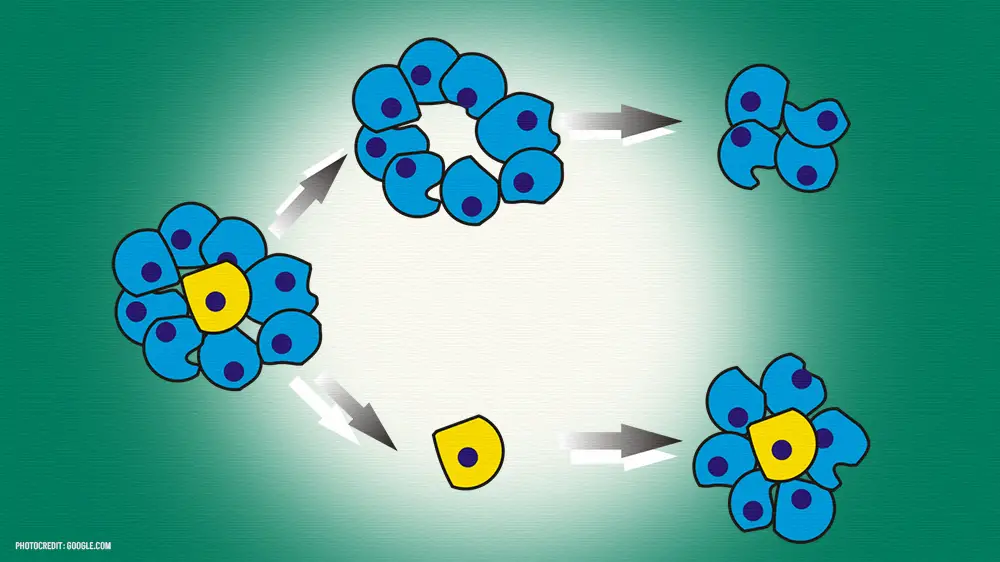
HEALTH BLOG
Stem Cell Therapy for Cancer A Revolutionary Approach to Treatment
-
Rahul Priydarss
Explore the cutting-edge realm of stem cell therapy for cancer in this comprehensive guide. Uncover its mechanisms, benefits, and potential for future advancements. Gain insights from real patient testimonials, offering a firsthand perspective on the efficacy of this innovative treatment. Delve into the history, current landscape, and future directions of stem cell therapy in oncology. Elevate your understanding of this transformative approach to cancer treatment. Learn more at
Introduction to Stem Cell Therapy For Cancer:
Stem cell therapy for cancer represents a cutting-edge approach in the realm of oncology. Harnessing the remarkable regenerative potential of stem cells, this innovative treatment offers new hope in the fight against cancer. Unlike traditional cancer therapies such as chemotherapy and radiation, which often cause significant collateral damage to healthy tissues, stem cell therapy aims to target and destroy cancer cells with precision.
By utilizing the body’s own natural healing mechanisms, stem cell therapy holds the promise of not only treating cancer but also regenerating damaged tissues and restoring overall health. In this introductory exploration, we will delve into the fundamentals of stem cell therapy for cancer, exploring its mechanisms of action, potential benefits, and the latest advancements in research and clinical practice. Join us on this journey as we uncover the transformative potential of stem cell therapy in the battle against cancer.

Table of Contents
What is Stem Cell Therapy For Cancer:
Stem cell therapy for cancer represents a pioneering approach in the field of oncology, harnessing the unique regenerative capabilities of stem cells to combat malignant tumors. In this section, we delve into the intricacies of this innovative treatment modality, exploring its mechanisms of action, therapeutic potential, and clinical applications.
Mechanisms of Action Stem Cell Therapy for Cancer:
At the core of stem cell therapy for cancer lies its remarkable mechanism of action, which involves the utilization of specialized cells known as stem cells. These cells possess the remarkable ability to differentiate into various cell types, making them invaluable for regenerative medicine and cancer treatment. When introduced into the body, stem cells can migrate to the site of the tumor, where they exert their therapeutic effects through several mechanisms.
Direct Attack on Cancer Cells: Stem cells have the capacity to directly target and destroy cancerous cells within tumors, effectively reducing tumor burden and inhibiting disease progression.
Stimulation of Immune Response: Stem cells can modulate the immune system’s response to cancer, enhancing the body’s ability to recognize and eliminate malignant cells through immune-mediated mechanisms.
Regulation of Tumor Microenvironment: Stem cells play a crucial role in shaping the tumor microenvironment, influencing factors such as inflammation, angiogenesis, and metastasis, which are essential for tumor growth and progression.
Clinical Applications of Stem Cell Therapy for Cancer:
Stem cell therapy for cancer has demonstrated promising results across various types of malignancies, with notable applications in the treatment of hematologic cancers such as leukemia, lymphoma, and multiple myeloma. Additionally, ongoing research is exploring the potential of stem cell therapy in solid tumors, including breast cancer, lung cancer, and brain tumors.
History of Stem Cell Therapy for Cancer:
Stem cell therapy for cancer is a relatively young field, but its roots can be traced back a few decades. Here’s a quick look at its historical journey.
1970s: The concept of “cancer stem cells” emerges, suggesting a subpopulation of cancer cells with stem-like properties that fuel tumor growth. This paves the way for targeted therapies using stem cells.
1980s: Hematopoietic stem cell transplantation (HSCT) becomes a well-established treatment for blood cancers like leukemia. This is the first and only widely used form of stem cell therapy in cancer currently. HSCT involves transplanting healthy stem cells to rebuild the patient’s blood and immune system after high-dose chemotherapy or radiation.
1990s and Early 2000s: Isolation and characterization of stem cells from various sources like bone marrow and adult tissues take center stage. Research focuses on understanding stem cell properties and their potential for cancer therapy beyond HSCT.
2000s – Present: The discovery of cancer stem cells reignites interest in using stem cells to target the root of the problem. Researchers explore modifying stem cells to deliver anti-cancer drugs directly to tumors or to differentiate them into immune cells that fight cancer.
Understanding Stem Cell Therapy for Cancer:
Stem cell therapy has become a hot topic in cancer treatment, offering a glimpse of a future where the body’s own repair mechanisms can be harnessed to fight the disease. But what exactly is it, and how realistic are the expectations? Let’s delve deeper.
What is Cancer?:
Cancer is a complex and multifaceted disease characterized by the uncontrolled growth and spread of abnormal cells within the body. These abnormal cells, known as cancer cells, have the ability to invade surrounding tissues and organs, disrupting their normal function. Cancer can arise in virtually any part of the body and can manifest in various forms, including solid tumors (such as breast, lung, and prostate cancer) or hematologic malignancies (such as leukemia and lymphoma).
Current Treatment Methods:
The treatment of cancer typically involves a combination of modalities aimed at eradicating cancer cells, controlling disease progression, and improving the patient’s quality of life. Some of the most common treatment methods for cancer include.
Surgery: Surgical intervention involves the removal of cancerous tumors and surrounding tissue in order to eliminate cancer cells and prevent further spread. Surgery is often used as a primary treatment for localized cancers or as part of a multimodal approach in combination with other therapies.
Chemotherapy: Chemotherapy utilizes drugs to kill cancer cells or inhibit their growth and replication. These drugs can be administered orally or intravenously and may be used alone or in combination with other treatments such as surgery or radiation therapy.
Radiation Therapy: Radiation therapy involves the use of high-energy radiation beams to target and destroy cancer cells. This treatment modality is often employed to shrink tumors, alleviate symptoms, or eradicate remaining cancer cells following surgery.
Immunotherapy: Immunotherapy harnesses the body’s immune system to recognize and attack cancer cells. This approach may involve the use of immune checkpoint inhibitors, adoptive cell therapy, or therapeutic vaccines to enhance the immune response against cancer.
Targeted Therapy: Targeted therapy targets specific molecules or pathways that are essential for the growth and survival of cancer cells. These therapies are designed to block the aberrant signaling pathways driving cancer growth while sparing normal cells.
Hormone Therapy: Hormone therapy is used to treat hormone-sensitive cancers such as breast and prostate cancer by altering hormone levels in the body or blocking hormone receptors on cancer cells.
Stem Cell Therapy: Stem cell therapy is an emerging treatment modality that utilizes the regenerative properties of stem cells to target and eradicate cancer cells. This innovative approach holds promise for personalized cancer treatment and is being investigated in clinical trials for various types of cancer.
Potential of Stem Cell Therapy for Cancer:
Stem cell therapy in cancer treatment offers a revolutionary approach, potentially using the body’s own repair mechanisms to combat the disease. Let’s explore how it works and the exciting possibilities emerging from research and clinical trials.
How Stem Cell Therapy Works Against Cancer:
Stem cell therapy holds immense promise in the fight against cancer due to its unique mechanism of action. Here’s how it works.
Targeting Cancer Cells: Stem cells have the remarkable ability to seek out and selectively target cancerous cells within the body. Once administered, they migrate to the site of the tumor and directly attack cancer cells while sparing healthy tissue.
Regulating the Immune System: Stem cells play a crucial role in modulating the body’s immune response to cancer. They can enhance the immune system’s ability to recognize and destroy cancer cells, effectively boosting the body’s natural defenses against the disease.
Inducing Cell Death: Stem cells can trigger programmed cell death, known as apoptosis, in cancer cells. By activating apoptotic pathways, they can effectively eliminate cancer cells without harming surrounding healthy tissue.
Inhibiting Tumor Growth: Stem cells produce factors that inhibit the growth and proliferation of cancer cells. These factors can interfere with the signaling pathways that drive tumor growth, ultimately slowing down or halting the progression of the disease.
Research and Clinical Trials:
The potential of stem cell therapy for cancer is supported by extensive research and ongoing clinical trials. Here are some key areas of investigation.
Efficacy: Clinical trials are evaluating the efficacy of stem cell therapy in various types of cancer, including leukemia, lymphoma, breast cancer, and brain tumors. Preliminary results have shown promising outcomes, with some patients achieving complete remission or prolonged survival.
Safety: Safety is a paramount concern in stem cell therapy. Clinical trials are rigorously assessing the safety profile of different stem cell sources, delivery methods, and doses to ensure that the therapy is both effective and well-tolerated by patients.
Optimization: Researchers are exploring ways to optimize stem cell therapy for cancer by improving the targeting and delivery of stem cells to tumor sites, enhancing their survival and persistence within the body, and minimizing off-target effects.
Combination Therapies: Stem cell therapy is being investigated in combination with other treatment modalities, such as chemotherapy, radiation therapy, and immunotherapy. These combination approaches aim to synergistically enhance anti-cancer efficacy and improve patient outcomes.
Types of Cancer Treatable with Stem Cell Therapy:
Stem cell therapy holds promise for the treatment of various types of cancer. Here are some cancers that are being explored for stem cell therapy.
Leukemia: Stem cell therapy, particularly hematopoietic stem cell transplantation (HSCT), is used to treat various types of leukemia, including acute myeloid leukemia (AML) and acute lymphoblastic leukemia (ALL). HSCT can replace diseased bone marrow with healthy stem cells, potentially offering a cure for some patients.
Lymphoma: Stem cell transplantation is also utilized in the treatment of lymphomas such as Hodgkin lymphoma and non-Hodgkin lymphoma. It can help restore normal blood cell production and induce remission in patients with refractory or relapsed disease.
Multiple Myeloma: Stem cell transplantation, especially autologous stem cell transplantation, is a standard treatment approach for multiple myeloma. It involves collecting and storing a patient’s own stem cells before undergoing high-dose chemotherapy and then reintroducing the stem cells to help restore normal blood cell production.
Breast Cancer: While still investigational, stem cell therapy shows promise for certain subtypes of breast cancer, such as triple-negative breast cancer. Research is exploring the use of stem cells to deliver targeted therapies directly to tumor sites, potentially enhancing treatment effectiveness.
Brain Tumors: Stem cell therapy is being investigated as a potential treatment for brain tumors, including glioblastoma. Preclinical studies have shown promising results in using stem cells to target and deliver therapeutic agents to brain tumor cells.
Solid Tumors: Stem cell therapy is also being explored for various solid tumors, such as lung cancer, pancreatic cancer, and ovarian cancer. While its effectiveness for solid tumors is still under investigation, early studies suggest that stem cell therapy may enhance the efficacy of conventional treatments.
Listing Various Types of Cancer:
Certainly, here’s a list of various types of cancer.
- Breast cancer
- Lung cancer
- Prostate cancer
- Colorectal cancer
- Skin cancer (including melanoma)
- Leukemia
- Lymphoma
- Ovarian cancer
- Pancreatic cancer
- Brain cancer (including glioblastoma)
- Liver cancer
- Bladder cancer
- Kidney cancer
- Thyroid cancer
- Esophageal cancer

Effectiveness of Stem Cell Therapy for Each Type of Cancer:
Certainly! Here’s an overview of the effectiveness of stem cell therapy for each type of cancer.
Breast Cancer: While stem cell therapy is still under investigation for breast cancer, early studies suggest potential for targeted therapy delivery and enhancing treatment effectiveness.
Lung Cancer: Limited evidence exists regarding the effectiveness of stem cell therapy for lung cancer. Further research is needed to assess its efficacy in this type of cancer.
Prostate Cancer: Stem cell therapy is being explored as a potential treatment for prostate cancer, particularly in combination with other therapies. However, its effectiveness is still under investigation.
Colorectal Cancer: Stem cell therapy has shown promise in preclinical studies for colorectal cancer. Research is ongoing to evaluate its efficacy in clinical settings.
Skin Cancer (including Melanoma): Stem cell therapy is being investigated for skin cancer, including melanoma. Early studies suggest potential for targeted therapy delivery and tumor suppression, but further research is needed.
Leukemia: Hematopoietic stem cell transplantation (HSCT) is an established treatment for certain types of leukemia, such as acute myeloid leukemia (AML) and acute lymphoblastic leukemia (ALL), with high rates of remission and long-term survival.
Lymphoma: HSCT is also used in the treatment of lymphomas, including Hodgkin lymphoma and non-Hodgkin lymphoma, with favorable outcomes in some patients.
Ovarian Cancer: Limited evidence exists regarding the effectiveness of stem cell therapy for ovarian cancer. Further research is needed to evaluate its potential in this type of cancer.
Pancreatic Cancer: Stem cell therapy is being explored as a potential treatment for pancreatic cancer, but its effectiveness remains uncertain and requires further investigation.
Brain Cancer (including Glioblastoma): Stem cell therapy is under investigation for brain cancer, including glioblastoma. Preliminary studies suggest potential for targeted therapy delivery and tumor suppression, but more research is needed.
Liver Cancer: Limited evidence exists regarding the effectiveness of stem cell therapy for liver cancer. Further research is needed to assess its potential in this type of cancer.
Bladder Cancer: Stem cell therapy is still in the early stages of investigation for bladder cancer, and its effectiveness remains to be determined through clinical studies.
Kidney Cancer: Limited evidence exists regarding the effectiveness of stem cell therapy for kidney cancer. Further research is needed to evaluate its potential in this type of cancer.
Thyroid Cancer: Stem cell therapy is still in the experimental stages for thyroid cancer, and its effectiveness has not been established in clinical settings.
Esophageal Cancer: Limited evidence exists regarding the effectiveness of stem cell therapy for esophageal cancer. Further research is needed to assess its potential in this type of cancer.
Benefits of Stem Cell Therapy:
Stem cell therapy offers several potential benefits in the treatment of various diseases, including cancer. Here are some of the key advantages.
Reduced Side Effects: Unlike traditional cancer treatments such as chemotherapy and radiation therapy, which can cause significant collateral damage to healthy tissues, stem cell therapy offers the potential for reduced side effects. By specifically targeting cancer cells while sparing normal cells, stem cell therapy may result in fewer adverse effects on the patient’s overall health and quality of life.
Targeted Treatment: Stem cell therapy enables targeted delivery of therapeutic agents to tumor sites, enhancing treatment precision and effectiveness. Stem cells can be engineered to express specific anti-cancer agents or cytokines, allowing for localized delivery and sustained release within the tumor microenvironment. This targeted approach minimizes off-target effects and maximizes therapeutic efficacy.
Potential for Remission: Stem cell therapy holds the potential to induce remission or even cure certain types of cancer. By selectively targeting cancer stem cells, which are responsible for tumor initiation, progression, and recurrence, stem cell therapy aims to eradicate the root cause of the disease and prevent its recurrence. This offers the possibility of long-term disease control and improved survival outcomes for patients.
Cost and Accessibility of Stem Cell Therapy:
Stem cell therapy for cancer presents a beacon of hope, but navigating the realities of cost and accessibility is crucial. Here’s a breakdown of what to expect.
Cost Considerations:
The cost of stem cell therapy for cancer can vary significantly depending on several factors.
- Type of therapy: Stem cell transplantation (SCT) is generally more established and might have a more defined cost structure compared to newer, investigational therapies.
- Facility and location: The cost can vary depending on the hospital or treatment center you choose and its location.
- Pre-treatment workup and post-treatment care: These additional costs can add up and need to be factored in.
- Stem Cell Transplant (SCT): The cost can range anywhere approximately $10,750 to $25,000 USD In the US, costs can be significantly higher.
Important Note: These are just estimates, and the actual cost can vary greatly. It’s vital to get a detailed cost breakdown from your healthcare provider.
Finding the Right Treatment Center:
If you’re considering stem cell therapy for cancer, here are some resources to help you navigate accessibility.
- National Cancer Institute: National Cancer Institute: https://www.cancer.gov/
- ClinicalTrials.gov: https://clinicaltrials.gov/
- American Society of Clinical Oncology (ASCO): American Society of Clinical Oncology: https://www.asco.org/
Future Directions for Stem Cell Therapy:
Stem cell therapy represents a rapidly evolving field with the potential to revolutionize the treatment of various diseases, including cancer. Here are some future directions and possibilities for advancing stem cell therapy. Researchers are actively exploring several avenues to improve stem cell therapy for cancer.
Ongoing Research and Advancements:
- Engineering Enhanced Stem Cells: Modifying stem cells to express specific molecules that can target tumors more effectively or improve their ability to survive and function within the tumor microenvironment.
- Gene Editing for Precision: Utilizing CRISPR-Cas9 technology to edit the genes of stem cells, potentially creating therapies tailored to specific cancer mutations.
- Harnessing the Power of Natural Killer Cells: Research on using stem cells to generate large numbers of potent natural killer (NK) cells, a type of immune cell that can target and destroy cancer cells.
Possibilities for Improving Efficacy:
Several strategies are being pursued to enhance the efficacy of stem cell therapy. These include optimizing stem cell sources and characteristics, improving cell delivery techniques, enhancing cell survival and integration within the host tissue, and developing innovative combination therapies. Additionally, advancements in genome editing technologies, such as CRISPR-Cas9, offer the potential to precisely modify stem cells for targeted therapeutic interventions.
Enhancing Accessibility:
Improving the accessibility of stem cell therapy involves addressing various factors, including cost, regulatory barriers, and healthcare infrastructure. Efforts to streamline manufacturing processes, standardize treatment protocols, and establish regulatory frameworks can help reduce the cost and complexity of stem cell therapy, making it more accessible to patients worldwide. Furthermore, collaborations between academia, industry, and government agencies are essential for advancing research, fostering innovation, and translating scientific discoveries into clinical applications.
Personalized Medicine:
The future of stem cell therapy lies in personalized medicine approaches tailored to individual patient characteristics and disease profiles. By harnessing the power of patient-specific stem cells, researchers can develop personalized therapies that maximize efficacy and minimize adverse effects. Advances in induced pluripotent stem cell (iPSC) technology enable the generation of patient-derived stem cells for disease modeling, drug screening, and therapeutic development, paving the way for precision medicine in the era of regenerative medicine.
Patient Testimonials: Experiences with Stem Cell Therapy for Cancer:
Real-life patient testimonials provide valuable insights into the experiences of individuals undergoing stem cell therapy for cancer. Here are a few firsthand accounts.
Sarah’s Story: “After being diagnosed with leukemia, I was devastated and overwhelmed. Traditional treatments had limited success, and I was running out of options. That’s when I decided to explore stem cell therapy. The process was rigorous, but the results were remarkable. Thanks to stem cell transplantation, I achieved remission and regained my quality of life. Stem cell therapy gave me hope when I needed it most.”
John’s Journey: “Living with lymphoma was challenging, to say the least. Chemotherapy left me feeling drained and defeated. When my doctor suggested stem cell therapy as a potential treatment option, I was hesitant but hopeful. The procedure was a turning point in my journey. Not only did it help shrink my tumors, but it also gave me renewed energy and optimism. Stem cell therapy has been a game-changer for me.”
Emily’s Experience: “As a breast cancer survivor, I understand the toll that cancer treatment can take on the body and mind. Stem cell therapy offered me a ray of hope amidst the uncertainty. Although the road to recovery was long and arduous, stem cell transplantation gave me a new lease on life. I am grateful for the opportunity to share my journey and inspire others facing similar challenges.”
Statistics and Survey Data of Stem Cell Therapy for Cancer:
Look for reputable sources with data on patient experiences with stem cell therapy for cancer. You could mention the percentage of patients who reported improvement, the most common side effects, and overall patient satisfaction. Here are some resources you can explore.
- National Cancer Institute (https://www.cancer.gov/)
- American Cancer Society (https://www.cancer.org/)
- Leukemia & Lymphoma Society (https://www.lls.org/)
FAQs about Stem Cell Therapy for Cancer:
A1: Stem cell therapy is not a cure for cancer but can be an effective treatment option in certain cases, offering the potential for remission and improved quality of life.
A2: Risks of stem cell therapy for cancer include immune rejection, tumor formation, and potential complications from the procedure itself.
A3: The cost of stem cell therapy for cancer varies depending on factors such as the type of cancer, the stage of the disease, and the specific treatment protocol.
A4: Insurance coverage for stem cell therapy for cancer varies depending on the policy and the specific treatment being offered. Patients are advised to check with their insurance provider for details.
A5: The success rate of stem cell therapy for cancer varies depending on factors such as the type and stage of cancer, the patient’s overall health, and the specific treatment protocol. Patients should discuss potential outcomes with their healthcare provider.

-Please remember, to always consult with healthcare professionals or Doctors for personalised advice related to medical conditions.
Conclusion:
Stem cell therapy for cancer represents a groundbreaking approach in the field of oncology, offering new hope and possibilities in the fight against this complex disease. By harnessing the regenerative potential of stem cells, this innovative treatment modality aims to target cancer cells with precision, while minimizing collateral damage to healthy tissues. Throughout this exploration, we’ve delved into the fundamental mechanisms of stem cell therapy, its historical evolution, and its potential applications across various types of cancer.




